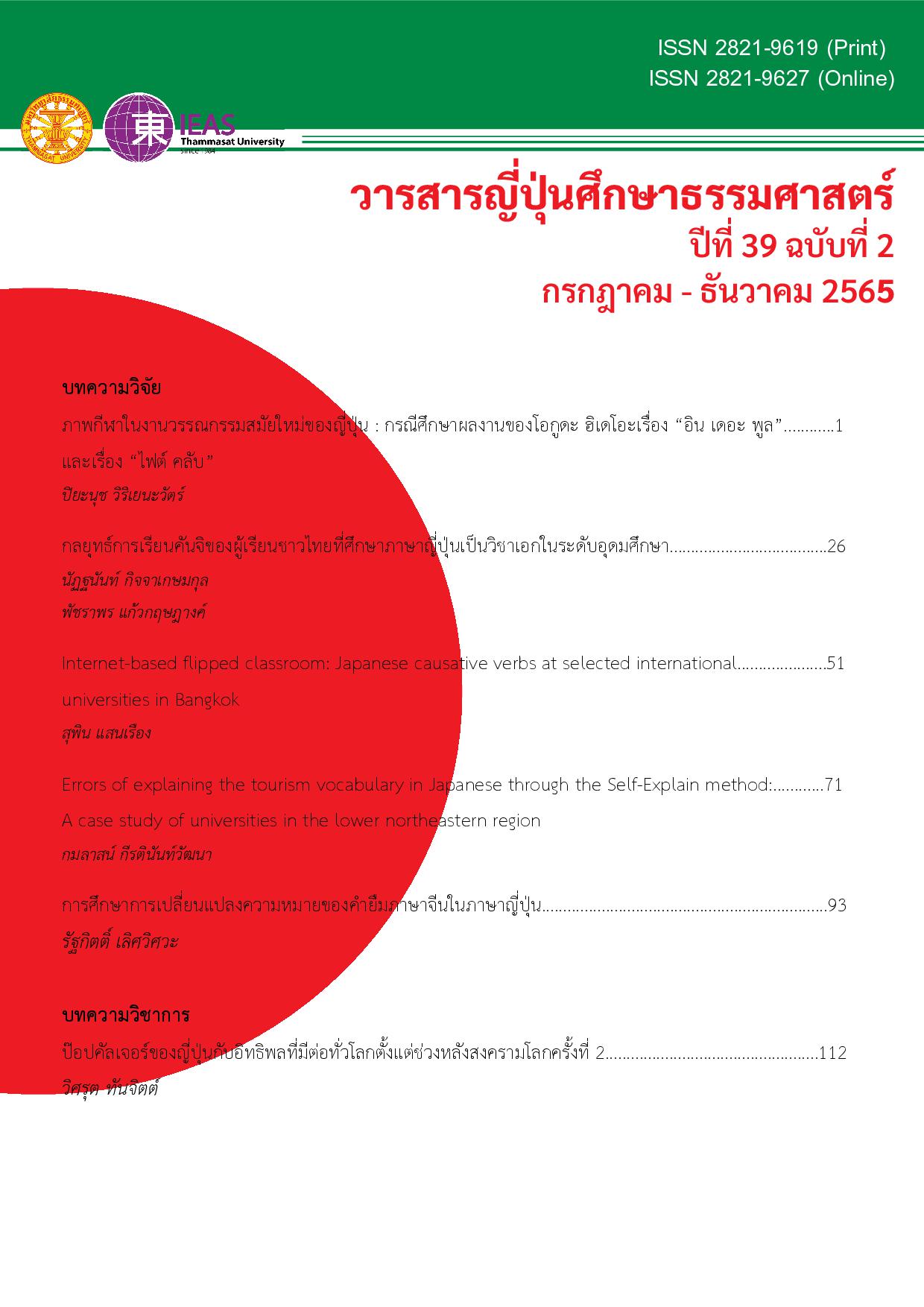Errors of explaining the tourism vocabulary in Japanese through the Self-Explain method: A case study of universities in the lower northeastern region
Keywords:
Principle of self-explain, tourism vocabulary, errors, Japanese touristsAbstract
This research aims to study the learning through self-explain principle in solving problems, answering questions and explaining vocabulary in Tourism field for Japanese tourists. It is used a combination of qualitative and quantitative research methods. The researcher collected data from 26 students from 2 University in lower north-east region who took the pre-test, training process, post-test. We analyze the errors of students.
The results of the research can be summarized as following: The self-explain principle and the principle of translator and interpreter can help students to improve in explaining tourism vocabulary better because of the shown errors. Totally, the students have improved their errors. The Pre-test ,the training stage and the Post-test showed the same trend namely; the most common grammatical errors were found, including auxiliary mistakes, word arrangements, and conjugation of verbs. Only in the practice stage showed the grammatical errors as following, auxiliary mistakes, conjugation of verbs and word arrangements. The second mistake was vocabulary and knowledge with the lowest percentage of errors. Grammar mistakes resulted from basic grammar that students are still careless in using it. The Vocabulary mistakes are made by learning process from the wrong things and the students do without checking which leads to using the wrong words. Finally, knowledge error, most of the students describe it with a narrow perspective by being self-centered which makes the explanation misleading.
Downloads
References
Agency for Cultural Affairs. Bunkachou. (2018). Wakariau tame no gengo communication (Report). Bunkachou bunkabu kokugoka. https://www.bunka.go.jp/koho_hodo_oshirase/hodohappyo/1401904.html
Asia Bunka Kaikan. (2003). 4Kyuubunpousoushiage nihongo nouryoku shiken4kyutaiou. TPA Press.
Banchongmanee, B. (2006). Shortcut to interpreter. Technology Promotion Association (Thailand-Japan): TPA.
Brown, A. (1993). Helping children’s write. Paul Chapman Publishing.
Catford, J.C. (1978). A linguistic theory of translation: An essay in applied linguistics. University Press.
Chawengkijwanich, S. (2014). On the use of Japanese particles showing location ‘ni’ and ‘de’ of Thai learners. Japanese Studies Journal, 30(2), 75-93.
Chawengkijwanich, S. (2019). Problems in Japanese to Thai translation: Problems in sentence construction. Journal of Liberal Arts, 20(1), 40 - 67.
_____. (2018). Concepts and techniques of Japanese-Thai translation. Thammasat University Press.
_____. (2016). Basic translation Japanese - Thai (Revised Ed). Technology Promotion Association (Thailand-Japan): TPA.
Cherdchu, P. (2016). Northeastern Thailand local ordination hall (Sim) in Yasothon province [Master’s thesis, Silpakorn University]. Silapakorn University Repository. http://www.sure.su.ac.th/xmlui/bitstream/id/73a3f227-ed9e-4eb3-83b3-1c8117175163/MA_Pimpun_Cherdchu.pdf?attempt=2
Dulay, H., Burt, M. & Krashern, S. (1982). Language two. Oxford University.
Iijima, M., Inasaki, Y., Inoue, M., Otani, R., Kokubu, T., Hoshino, Y. & Machida, K. Asia Bunka Kaikan (AKB). (2003). Kyuu bunpou sou shiage Nihongo nouryoukushiken shi-kyuu taiou. (4th Ed.). Technology Promotion Association (Thailand-Japan): TPA.
Ito, T. (2004). Jiko setsumei koka no riron to jissen. Keio gijuku daigaku daigakuin shakaigakukenkyuka bulletin, (59), 29 - 36. https://koara.lib.keio.ac.jp/xoonips/modules/xoonips/detail.php?koara_id=AN0006957X-00000059-0029
Kataoka, A., Yamamoto, K. & Masuyama, S. (2000, October 22). Summarization by shortening Japanese noun modifiers into expression “A no B”. Proceedings of NLPRS99 (pp. 409 - 414). https://www.researchgate.net/publication/2468745_Summarization_by_Shortening_a_Japanese_Noun_Modifer_into_Expression_A_no_B.
Kouriya, S. Y. (1999). Zokusei gainengo toshite no nihongo rentaisetsu NihongogakuNihongokkyouiku ronshuu. Nagoyagakuin daigaku ryuugakuseibetsuka, (6), 1 - 20.
Krachaechan, P (2018). The painted Baisema is the problem of confusing definition of ancient sites. Matichononline. https://www.matichon.co.th/columnists/news_1186397
Ministry of Tourism and Sports. (2019). Domestic tourism statistics 2019. https://www.mots.go.th/more_news_new.php?cid=618
Neancharoensuk, S. (2008). Advanced Japanese language Thai learners’ errors analysis: focus on writing skill. Journal of Liberal Arts Thammasat University, 8(1), 109-131.
Neancharoensuk, S. (2021). Error analysis of Japanese essays written by beginner level Thai students. Journal of Liberal Arts Thammasat University, 21(2), 1-29.
Neuman, Y. & Schwarz, B. (2000). Substituting one mystery for another: The role of self-explanations in solving algebra word problems. Learning and Instruction, 10(3), 203 - 220. https://doi.org/10.1016/S0959-4752(99)00027-4
Pholboon, P. (2018). An analysis of stage play script translation: Problems and factors contributing to errors. Journal of Language Religion and Culture, 7(2), 361 - 391.
Ratpiyapaporn, C. (1998). A study of belief and iconography of “Yaksas” depicted on sculptures found in Thailand [Master’s thesis, Silpakorn University]. Silapakorn University Repository: SURE. http://www.sure.su.ac.th/xmlui/handle/123456789/1245?attempt=&
Roy, M. & Chi, M. T. H. (2012). The self-explanation principle in multimedia learning. Cambridge University Press.
Saito, H. (2002). Rentai shuushokusetsu no shuutoku ni kansuru kenkyuu no doukou. Ochanomizujoshidaigaku Nihon gengo bunkagakukenkyuukai kiyouronbun. https://teapot.lib.ocha.ac.jp/records/40595#.YoRvFHVBy5c
Suwannakhoot, P. (2016). Error analysis of Japanese language learners via application line. The journal of Humanities and Social Sciences Rangsit University, 8(14), 81 - 92.
Suwan, S. & Taothong, S. (2019). Himmapan creatures from imagination: Influences from beliefs and drawings of Surasak Charoenwong. Journal of Humanities, Social Sciences and arts, 12(6), 2557 - 2578.
Taedaeng, P. & Pimthong, M. (2008). Japanese for traveling in Thailand. Chulalongkorn University.
Tangtrongsitthikul, S. (2018). City pillar: The development of concept to art & architecture. [Doctoral dissertation, Silpakorn University]. Dspace Silapakorn University. http://ithesis-ir.su.ac.th/dspace/handle/123456789/1844
Tokyo University of Foreign Studies. (2022). Tokyo University of Foreign Studies Language Module. http://www.coelang.tufs.ac.jp/ja/th/gmod/contents/explanation/053.html
Downloads
Published
Issue
Section
License
Copyright (c) 2022 Thammasat Journal of Japanese Studies

This work is licensed under a Creative Commons Attribution-NonCommercial-NoDerivatives 4.0 International License.




